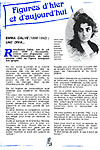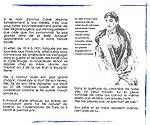
vous êtes ici : accueil > articles > Emma Calve > Biographie
Cette page contient les ressources suivantes :
Biographie de Emma Calve
Emma Calve (1858 - 1942)
retour aux grands personnages
inhumés à Bourg-la-Reine
The historical association Bourg-la-Reine de Jadis à Demain was founded in February 1992. It aims at making known, protecting and safeguarding the historical, cultural and natural heritage of the town of Bourg-la-Reine.The emblem that characterizes it represents:
- on the one hand, an arch of the ancient parish church of Bourg-la-Reine, built in the thirteenth century, and which can be admired to this day, in the private garden at 40, Boulevard Joffre.
This is a symbol of the past.
- on the other hand, the tower of Villa Hennebique situated at 22 Avenue Victor Hugo, bearing the name of its owner François Hennebique who was the first, in France, to use reinforced concrete.
This is a symbol of the future.Situated on the ancient Roman causeway from Paris to Orléans, Bourg-la-Reine was witness to numerous historic events. Celebrities have lived or been laid to rest here; for this reason, our Association would like to help you discover these famous personalities thanks to the research and writings undertaken by its members, to maintain a collective record and to ensure a cultural heritage that can be bequeathed to our children.
Philippe CHAPLAIN
President of the Association
Chaplainph@wanadoo.fr
BIOGRAPHIE
On the occasion of the 50th death anniversary of the singer Emma Calvé, whose family lived in Bourg-la-Reine, we wished to share with our readers our admiration for this star of the grande époque.
Rosa Emma Calvé, born on August 15, 1858 at Decazeville had a scintillating career as a singer in the 1900s, when the opera had reached its zenith. Formerly a salesgirl for gloves, at Millau, she could neither read music nor play the piano. With hard work and a strong determination to progress in her efforts, she very quickly got rid of her accent, which was marked with sonorités rourgates*, in order to develop a voice of prima donna assoluta, which she devoted almost entirely to singing, notably in the role of Bizet's Carmen, which she was to play more than 1300 times! She became the driving force behind famous composers such as Massenet and Reynaldo Hahn. A grateful nation awarded her with the Chevalier de la Légion d'Honneur.
As a pioneer of the impressive shows in the style of Barnum, touring the world from Paris to New York via Rome, she became the idol of public passion and won the admiration of the most famous personalities of the period. Queen Victoria considered her to be a friend and invited her to Windsor. She even had a marble bust of her effigy sculpted to adorn a vestibule in her castle.After a banquet, Grand Duke Nicholas, without the least hesitation, spread out his fur-coat in front of her, on the snow, setting the example for the dignitaries of his escort so that she could walk to her vehicle without getting her feet wet!
* intonations from the region of Rouergue.
Driven by an insatiable curiosity she studied spiritualism, Yoga, Hinduism
and Buddhism. One finds her immoderate passion reflected in a baroque,
medieval castle in Cabrières, which swallowed up a good part of
her wealth.
She is believed to have had several love-affairs; however, after a marriage to an Italian tenor, which ended in divorce, the only true love of her life was Henri Cain. This brilliant young man, who belonged to the smart set of Paris, was a writer and portrait painter who eventually married Emma's partner-singer in Massenet's Navarraise.
If the name of Emma Calvé sounds familiar to some of our fellow citizens, it is because they can take pride in the fact that she who was called "the greatest diva of the Belle Epoque" was part of our local history. In fact, after the tiring tours in the United States, undertaken with the dual intention of convincing the Americans to join the war, as well as to collect funds for the Red Cross, an exhausted Emma Calvé came to Bourg-la-Reine in 1914, to take rest at her mother Léonie's place, at 2 rue Brun (formerly known as rue du Potager). In 1919, on her return from a course of treatment at Contrexeville, she stayed for a while at rue Dispan in l'Hay-les-Roses, in a convalescent home run by Dr. Gaston Maillard whose son was a pharmacist in Bourg-la-Reine.
This woman of strong personality liked to think that even her dog knew
how to sing! Nonetheless, she never forgot her modest beginnings; striking
workers near Porte d'Orleans, who stopped a tramcar in which she was travelling,
were taken by surprise when she encouragingly yelled out to them, "I
too am the daughter of a worker!"
Emma Calvé died on January 6, 1942 following a hepatic illness.
Two days before her death a radio journalist from the Office de radiodiffusion
managed to record her last words: "It is time to leave, I have no
strength left." She was buried in the cemetery of Millau, her grave
marked by a simple tombstone, forgotten by all....
It was at Bourg-la-Reine that Emma Calvé faced her most tragic experience, with the dying of her nephew Elie, the son of her brother Adolphe who lived at 27 Avenue Galois. The young man died on July 2, 1929, felled by a stroke the very moment he heard that he had been awarded the prize for the best actor, by the Conservatoire de Paris, for his role as the "natural son" of Diderot. In order to prevent the body from being transferred to the morgue the doctor present certified the death to have taken place due to "serious illness".The actor was therefore transported to L'Hôpital de la Pitié.
In her memoirs entitled "Sous tous les ciels, J'AI CHANTE",
Emma writes: "..........Cruel Grief. Paris, July 2, 1929. My nephew,
my son, my child, because I was his second mother, has just been taken
away from us by a jealous God. He left home at noon, filled with hope,
to compete at the Conservatory. While kissing me he said: 'You'll see,
godmother, what a lovely first prize I'm going to bring you. I, too, shall
be an artiste. Do not come to the hall, neither you nor mother, you will
make me nervous.' Looking at his mother and sending her a flying kiss,
he said, 'I take you with me in my heart.' At 3 o'clock we were informed
that he was dead! He died of an embolism in the brain, the very moment
his master informed him of his success. Died of emotion, died of joy!
The cries, the tears of his poor parents: the mother filled with horror,
the father utterly dismayed. Words cannot describe this catastrophe. Our
only child, our only joy, he who was so good and so handsome, to see him
never again! My voice has left with him. I feel I will henceforth never
be able to sing again......."
Born in Aurillac (Cantal) on July 20, 1904, Elie - an extremely sensitive
boy - was, for a while, treated by the psychiatrist Babinski. A friend
of Cornelissen (Dutch revolutionary journalist who lived in Bourg-la-Reine),
he wrote poems for Le Bleuet - the magazine of Lycée Lakanal. He
was admitted to the Conservatory of Paris in October 1928. His master
Mr. Leitner as well as the renowned artiste Mademoiselle Bartet had predicted
a brilliant career for him.
In the calm cemetery of Bourg-la-Reine, the tombstone of the one who shared the same fate as Molière's, is marked by the words: "Do not grieve for me, I died out of joy." His father and his mother were laid to rest close to him.
Bibliography :
- Contrucci Jean, Emma CALVE, la Diva du siècle.
- Girard Georges, Emma CALVE, la cantatrice sous tous les ciels.
- Calvé Emma, Sous tous les ciels, J'AI CHANTE
- Chaplain Philippe, "Emma CALVE", Bourg-la-Reine Magazine,
February 1992.
- Cussac Jean, Souvenirs d'Elie CALVE, December 1935.
Interviews :
- Annie BESNIER, historian, l'Hay-les-Roses.
- Suzanne DISPAN, friend of Emma Calvé, l'Hay-les-Roses.
- Marcelle ROLLET, former Secretary to the Mayor, Bourg-la-Reine.
- Suzanne SIMONA, friend of Marguerite PUECH, mother of Elie CALVE, Bourg-la-Reine.

